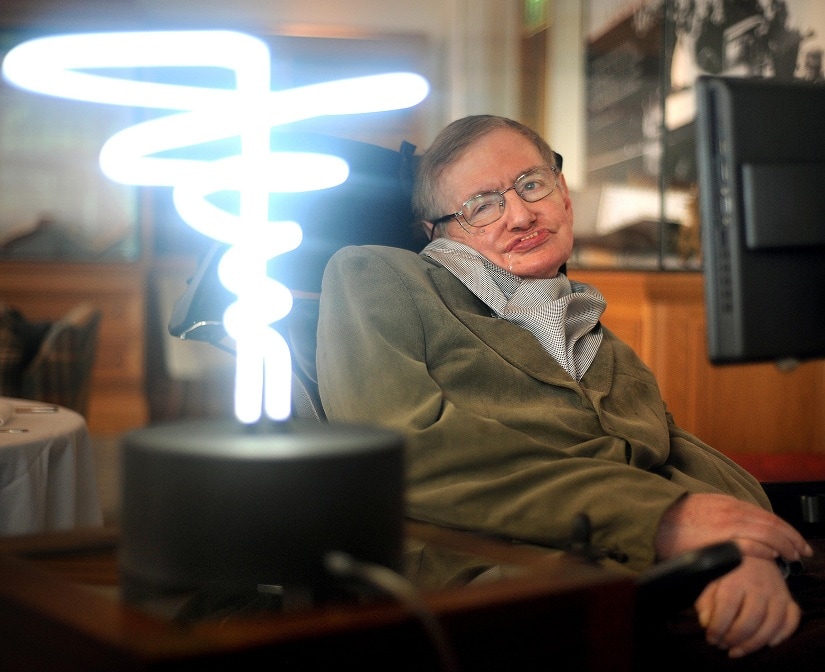Ask most entrants to a physics programme why they are interested in the subject, and as often as not, the answer will be that they read A Brief History of Time by Stephen Hawking. Hawking died on 14 March 2018 at the age of 76. This was announced in real time in my physics class, and at least one student — of economics — was visibly sad later at tea. Even those who have not read the book associate Hawking’s name with fundamental discoveries about space and time. The only comparison one can make is with the way Einstein was regarded by the general literate public all over the world by the 1930s. Some of this special status is a consequence of Hawking’s own long struggle against physical disability — he was diagnosed with ALS (Amyotrophic Lateral Sclerosis), a disease of the motor nervous system, and given two years to live at the age of 21. He lived 55 years longer! As if that was not enough, he chose to become a very public figure in his later life, in spite of having to put in enormous effort to travel and give talks. For a large part of his life, all talks were delivered by a computerised speech synthesiser — he used to apologise for his American accent! Hawking took up difficult questions and gave decisive answers in areas where one might say angels fear to tread. Had physics come to an end? He thought it had but had to change his mind. Do the laws of fundamental physics allow information to disappear? He first said yes and then withdrew his claim as the subject developed. Does God exist (no; he was an atheist). Should we as humans search for extraterrestrial intelligence? He said we must and he put in significant time in organising very visionary and futuristic plans, supporting the Russian physicist-billionaire Yuri Milner. [caption id=“attachment_4390477” align=“alignnone” width=“825”]  In this February 2012 image, Professor Stephen Hawking poses beside a lamp titled ‘black hole light’ by inventor Mark Champkins. AP Photo[/caption] This very public life and his own evolution into his self-appointed role as spokesman on fundamental issues took their toll. Both his marriages ended in divorce. The first was to Jane Wilde who supported him through 30 years — the onset of his illness and the period of his best work, and ended in 1995. The second, to his former nurse Elaine Mason, ended in 2007. This kind of life is the stuff of which legends are made. It is natural to ask what the substance behind the legend is — and substance there is, in abundance. In Hawking’s case, as in Einstein’s, this elevation to near mythic status was not confined to the general public. Most physicists including many people who worked in the same area that he did, were awed by the originality and the magnitude of his contributions. One of the peers well qualified to put them in perspective is Roger Penrose, and the obituary he wrote in The Guardian should be consulted for a more detailed account of his scientific contributions and the context in which they were made. The connection to Einstein is only made stronger because his area of work was essentially the same as Einstein’s, though in a modern form. It is called general relativity — GR for short, a geometric explanation of gravity created by Einstein. If it had to be summarised non-mathematically in one sentence, the best is probably due to the American physicist John Wheeler — matter tells space how to curve, and (curved) space tells matter how to move. In the process, gravity emerges naturally. The equations of GR were written down in 1915 but progress in solving the equations was slow and confined to very symmetric situations — Einstein himself was able to extract much of the physics by making approximations. Exact results were few and far between (and two of them were from pre-independence India, due to Banerjee in Kolkata and Vaidya in Varanasi). The two most important solutions were for a collapsing star due to Oppenheimer and Snyder in the US in 1939, and for an expanding universe found by Friedmann in the USSR in 1922. In both problems, the symmetric version of GR predicted that there would be a “singularity”. This is another way of saying that the mathematical solution becomes physically meaningless because some quantities blow up to infinite values. Many people believed that this was just a consequence of the simplifications made and realistic solutions would not exhibit this behavior. It is in this context that Penrose and Hawking (working both separately and together) in the period 1965-1970, were able to give arguments proving that such singularities were an essential part of GR. Today astronomers take the big bang origin of the universe as well as the existence of black holes as a given — even as commonplace — and of course, both are backed by extensive agreement of the models based on GR with observations. This revolution would not have been possible without the theorems proved by Hawking and Penrose, who in the process invoked and created new mathematical tools which did not require symmetry — these are called ‘global’. One is often asked why this work did not win a Nobel Prize. In fact, when Chandrasekhar won the Nobel Prize in 1983 for his fundamental work on stellar collapse, these two scientists would have been worthy partners in the award, having contributed fundamentally to the fate of massive stars. This oversight may also reflect the inherent conservatism of the Nobel process — in 1983 the observational evidence for white dwarfs and their limiting mass, as worked out by Chandrasekhar, was overwhelming. Black holes were still finding their place both in astronomical journals and in the sky. The best example for this conservatism is that Einstein’s own Nobel citation of 1921 did not mention relativity, but only ‘services to theoretical physics’! Hawking did not stop with putting black holes on a firm theoretical footing. Many of their properties were then worked out, with colleagues, particularly Carter and Bardeen. One intriguing result was the ‘Area theorem’ which states that the area of the black hole — the surface from which light could not escape — must always increase with time. This was reminiscent of the well-known second law of thermodynamics which states that the ‘entropy’ — a measure of disorder — always increases with time. At that time, Hawking felt this was a just an analogy and said as much — because it was hard to conceive of disorder in such an object. Very soon, a fundamental paper appeared, by a young student at Princeton University, Jakob Bekenstein. This paper argued, using the wave nature of particles dropped into a black hole, that there was indeed a disorder, proportional to the area. Hawking was forced to revisit the entropy of black holes, now using quantum physics. This is arguably one of Hawking’s most original contributions, instantly regarded as a breakthrough. This is the place to mention Einstein’s other major preoccupation (the one cited in his Nobel award!) — namely, the quantum theory. This is the theory which describes the wave like behaviour of electrons on the scale of atoms, and the resulting uncertainty in their position and velocity. Physicists have always known that this ‘wave like’ mathematics and the consequent physical uncertainties must extend beyond the realm of atoms, but extending to the realm of gravity was and still is an unsolved problem. One of the very few established results in this field is due to Hawking — a black hole will emit radiation like a hot body with a certain well defined temperature inversely related to its mass. It is therefore associated with entropy as well. What is remarkable about this result is that it does not give a precise picture of what the disorder is — but it says it must be there in any theory of quantum gravity. Generations of physicists have followed, each with their favourite model combining gravity and quantum theory verifying Hawking’s calculation of temperature, radiation, and entropy — and attempting to improve upon it. Unfortunately, this radiation is predicted to be the strongest for very tiny black holes which are not the ones seen by astronomers today — so early hopes that they would be detected as explosions proved to be illusory. This only brings us to the year 1974! Appointed as the Lucasian Professor at Cambridge University in 1979, Hawking was a successor to Isaac Newton, who occupied the chair 310 years earlier. He also followed a 20th century legend Paul Dirac, one of the early creators and foremost practitioners of quantum theory. His department naturally became a Mecca for those pursuing fundamental issues in theoretical physics and he kept a close eye on developments in particle physics, particularly the ‘grand unified theories’ which were coming into vogue at that time. It is fair to say that his work and claims in this area do not match his work on black holes. From a distance, one has to rely mainly on other accounts of his personality. But having been present during his visit to the Tata Institute of Fundamental Research in 2001, I can add some first-hand snippets. An entire floor of a hotel was needed to accommodate the group of support staff — doctors, nurses, computers, diet, etc — accompanying him. Their task was not made easier by Hawking’s appetite for new places and experiences — on his very first evening he was seen in a famous garden of Mumbai! His talk was of course prepared in advance but when it came to question time, he showed great seriousness and patience in tapping out the answers with just one hand onto the device which he needed to frame any sentence. And he took full part in the conference which was on string theory, the latest effort of physicists to combine quantum theory and gravity. This piece has gone into more technical detail than the typical obituary to answer a question which may strike many readers: Is the legend of Stephen Hawking a product of the current media-mad sensation-seeking age? As someone who has followed the astronomy as well as basic physics literature over the period of Hawking’s work, my answer is simple. You could strip away all the sensational aspects of his life — his illness, his struggle, his conscious rise to a public figure, his provocative pronouncements on physics as well as other matters, and his personal life. However, the scientific legacy that remains, will be in physics textbooks a hundred years from now — even as that of Einstein is in today’s books. Hawking’s (and Penrose’s) work underlies the seemingly abstruse notion of black holes. Today, these objects are routinely seen at the centre of nearly every galaxy, ours included, and by every X-ray telescope including India’s own ASTROSAT ( see a recent post). This legacy will live on. And in the truly abstruse realm of quantum gravity, Hawking radiation and Bekenstein-Hawking entropy are the few lighthouses in a murky landscape. What more should one ask of a genuine legend? Rajaram Nityananda teaches physics at the Azim Premji University. He has worked earlier with Raman Research institute and Tata Institute of Fundamental Research.
You could strip away all the sensational aspects of Stephen Hawking’s life and the scientific legacy that remains, will be in physics textbooks a hundred years from now
Advertisement
End of Article


)

)
)
)
)
)
)
)
)



